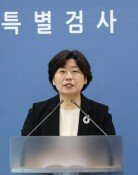Why has the U.S. Dispatched 24 Bombers to Guam?
Why has the U.S. Dispatched 24 Bombers to Guam?
Posted March. 07, 2003 22:28,
Is this simply repositioning in preparation for war with Iraq, or preparation for a strike on North Korea?
The United States has dispatched 24 bombers to Guam, and continues building up its military power around the Korean Peninsula. In the process, debate and tension have increased.
The official position of the United States is that it is augmenting its war deterrence in order to prevent any misjudgment on the part of the North Korean regime due to its concentration on the Iraq war. However, some Bush administration officials define the move as a precursor to a future attack on the isolated regime.
The military moves have already enforced, in addition to the deployment of 24 B-52 bombers to Guam, the dispatch of the nuclear-powered aircraft carrier USS Carl Vinson near the Korean Peninsula, extension of service for 2,900 U.S. solders now waiting assignment to new posts, and demand for augmentation of an additional 2,000 air force personnel.
The additional air force personnel, however, is to support the 24 bombers. In addition, the extension has arisen out of the Bush administration`s preparations for its war against Iraq. The administration has temporarily halted reassignment of all U.S. solders around the world.
Furthermore, the dispatch of the USS Carl Vinson is to make up for the loss caused by the Kitty Hawk`s move to the Gulf area, which was originally on a mission near Japan. Thus, according to military experts, it is easy to deny that the nuclear standoff with North Korea has caused the latest military moves.
Nonetheless, it is obvious that the bombers are deployed within striking distance from Pyongyang. In this respect, it is undeniable that the deployment was made with North Korea in mind.
Meanwhile, U.S. President George W. Bush has recently stressed that use of force is a last resort. Therefore, some interpret military augmentation made by the Defense Department will allow for as many options as there are available to its Commander in Chief.
Major U.S. newspapers including The New York Times reported that a similar action was taken in 1994, when the Clinton administration planned in detail, the bombing of North Korean nuclear facilities.
In fact, in early 1994 when the nuclear crisis was escalating, the U.S. government was reportedly considering deployment of Patriot missiles and Apache gun-ships to South Korea. In addition, sources confirmed at the time that Washington and Seoul were pondering over resumption of joint military exercises entitled ‘Team Spirit.’
At that time, Washington and Seoul explained that the actions were part of their 1989 joint project to beef up military readiness. Notwithstanding the denial, the nuclear crisis over the Korean Peninsula has since escalated.
And in March, in the wake of North Korea`s continuing threat, which reached its pinnacle with its "inferno" statement, the White House secretly set up in mid June an augmentation plan to bomb the nuclear facilities in North Korea.
Under the plan, 2,000 U.S. troops would be additionally dispatched. Then, bombers were to be sent near the peninsula, and evacuation was to be made of U.S. citizens in South Korea. Finally, the Clinton administration intended to send tens of thousands of more solders to South Korea.
But execution of the plan was put on hold due to former President Jimmy Carter`s visit to the North. During his visit, a compromise was reached between the two sides.
Comparing the plan to the present, a salient difference stands out. Back in 1994, deployment of bombers was made to serve a specific goal. On the other hand, this time, Washington sent bombers to Guam without taking into consideration any other preliminary measures in advance.
In this respect, Korean experts compare the bomber deployment to clay. They believe that the deployment is conceived to serve various purposes: warning Pyongyang, deterrence of armed provocation, and a possible spear in time of crisis.
sechepa@donga.com




![[단독]김영훈 후보자, 과태료-세금 체납으로 12차례 차량 압류](https://dimg.donga.com/c/138/175/90/1/wps/NEWS/IMAGE/2025/07/10/131975137.1.jpg)


